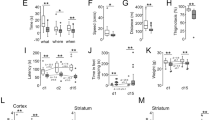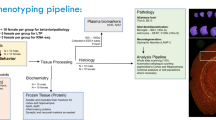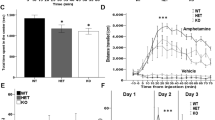Abstract
Normal aging of the brain differs from pathological conditions and is associated with increased risk for psychiatric and neurological disorders. In addition to its role in the etiology and treatment of mood disorders, altered serotonin (5-HT) signaling is considered a contributing factor to aging; however, no causative role has been identified in aging. We hypothesized that a deregulation of the 5-HT system would reveal its contribution to age-related processes and investigated behavioral and molecular changes throughout adult life in mice lacking the regulatory presynaptic 5-HT1B receptor (5-HT1BR), a candidate gene for 5-HT-mediated age-related functions. We show that the lack of 5-HT1BR (Htr1bKO mice) induced an early age-related motor decline and resulted in decreased longevity. Analysis of life-long transcriptome changes revealed an early and global shift of the gene expression signature of aging in the brain of Htr1bKO mice. Moreover, molecular changes reached an apparent maximum effect at 18-months in Htr1bKO mice, corresponding to the onset of early death in that group. A comparative analysis with our previous characterization of aging in the human brain revealed a phylogenetic conservation of age-effect from mice to humans, and confirmed the early onset of molecular aging in Htr1bKO mice. Potential mechanisms appear independent of known central mechanisms (Bdnf, inflammation), but may include interactions with previously identified age-related systems (IGF-1, sirtuins). In summary, our findings suggest that the onset of age-related events can be influenced by altered 5-HT function, thus identifying 5-HT as a modulator of brain aging, and suggesting age-related consequences to chronic manipulation of 5-HT.
This is a preview of subscription content, access via your institution
Access options
Subscribe to this journal
Receive 12 print issues and online access
$259.00 per year
only $21.58 per issue
Buy this article
- Purchase on Springer Link
- Instant access to full article PDF
Prices may be subject to local taxes which are calculated during checkout






Similar content being viewed by others
References
Resnick SM, Pham DL, Kraut MA, Zonderman AB, Davatzikos C . Longitudinal magnetic resonance imaging studies of older adults: a shrinking brain. J Neurosci 2003; 23: 3295–3301.
Sowell ER, Peterson BS, Thompson PM, Welcome SE, Henkenius AL, Toga AW . Mapping cortical change across the human life span. Nat Neurosci 2003; 6: 309–315.
Terry RD, DeTeresa R, Hansen LA . Neocortical cell counts in normal human adult aging. Ann Neurol 1987; 21: 530–539.
Bertoni-Freddari C, Fattoretti P, Paoloni R, Caselli U, Galeazzi L, Meier-Ruge W . Synaptic structural dynamics and aging. Gerontology 1996; 42: 170–180.
Pakkenberg B, Gundersen HJ . Neocortical neuron number in humans: effect of sex and age. J Comp Neurol 1997; 384: 312–320.
Park DC, Lautenschlager G, Hedden T, Davidson NS, Smith AD, Smith PK . Models of visuospatial and verbal memory across the adult life span. Psychol Aging 2002; 17: 299–320.
Thibault O, Hadley R, Landfield PW . Elevated postsynaptic [Ca2+]i and L-type calcium channel activity in aged hippocampal neurons: relationship to impaired synaptic plasticity. J Neurosci 2001; 21: 9744–9756.
Davare MA, Hell JW . Increased phosphorylation of the neuronal L-type Ca2+ channel Cav1.2 during aging. Proc Natl Acad Sci USA 2003; 100: 16018–16023.
Verkhratsky A, Toescu EC . Calcium and neuronal ageing. Trends Neurosci 1998; 21: 2–7.
Lerer B, Gillon D, Lichtenberg P, Gorfine M, Gelfin Y, Shapira B . Interrelationship of age, depression, and central serotonergic function: evidence from fenfluramine challenge studies. Int Psychogeriatr 1996; 8: 83–102.
Mattson MP, Magnus T . Ageing and neuronal vulnerability. Nat Rev Neurosci 2006; 7: 278–294.
Meltzer CC, Smith G, DeKosky ST, Pollock BG, Mathis CA, Moore RY et al. Serotonin in aging, late-life depression, and Alzheimer's disease: the emerging role of functional imaging. Neuropsychopharmacology 1998; 18: 407–430.
Reynolds III CF, Kupfer DJ . Depression and aging: a look to the future. Psychiatr Serv 1999; 50: 1167–1172.
Morrison JH, Hof PR . Life and death of neurons in the aging brain. Science 1997; 278: 412–419.
Carlsson A . Neurotransmitter changes in the aging brain. Dan Med Bull 1985; 32 (Suppl 1): 40–43.
Davidoff MS, Lolova IS . Age-related changes in serotonin-immunoreactivity in the telencephalon and diencephalon of rats. J Hirnforsch 1991; 32: 745–753.
Nishimura A, Ueda S, Takeuchi Y, Matsushita H, Sawada T, Kawata M . Vulnerability to aging in the rat serotonergic system. Acta Neuropathol (Berlin) 1998; 96: 581–595.
Arango V, Ernsberger P, Marzuk PM, Chen JS, Tierney H, Stanley M et al. Autoradiographic demonstration of increased serotonin 5-HT2 and beta-adrenergic receptor binding sites in the brain of suicide victims. Arch Gen Psychiatry 1990; 47: 1038–1047.
Marcusson J, Oreland L, Winblad B . Effect of age on human brain serotonin (S-1) binding sites. J Neurochem 1984; 43: 1699–1705.
Marcusson JO, Morgan DG, Winblad B, Finch CE . Serotonin-2 binding sites in human frontal cortex and hippocampus. Selective loss of S-2A sites with age. Brain Res 1984; 311: 51–56.
Bach-Mizrachi H, Underwood MD, Kassir SA, Bakalian MJ, Sibille E, Tamir H et al. Neuronal tryptophan hydroxylase mRNA expression in the human dorsal and median Raphe nuclei: major depression and suicide. Neuropsychopharmacology 2005; 31: 814–824.
Meltzer CC, Smith G, Price JC, Reynolds III CF, Mathis CA, Greer P et al. Reduced binding of [18F]altanserin to serotonin type 2A receptors in aging: persistence of effect after partial volume correction. Brain Res 1998; 813: 167–171.
Goldberg S, Smith GS, Barnes A, Ma Y, Kramer E, Robeson K et al. Serotonin modulation of cerebral glucose metabolism in normal aging. Neurobiol Aging 2004; 25: 167–174.
van Luijtelaar MG, Tonnaer JA, Steinbusch HW . Aging of the serotonergic system in the rat forebrain: an immunocytochemical and neurochemical study. Neurobiol Aging 1992; 13: 201–215.
Mattson MP, Maudsley S, Martin B . A neural signaling triumvirate that influences ageing and age-related disease: insulin/IGF-1, BDNF and serotonin. Ageing Res Rev 2004; 3: 445–464.
David DJ, Bourin M, Hascoet M, Colombel MC, Baker GB, Jolliet P . Comparison of antidepressant activity in 4- and 40-week-old male mice in the forced swimming test: involvement of 5-HT1A and 5-HT1B receptors in old mice. Psychopharmacology (Berlin) 2001; 153: 443–449.
Trillat AC, Malagie I, Scearce K, Pons D, Anmella MC, Jacquot C et al. Regulation of serotonin release in the frontal cortex and ventral hippocampus of homozygous mice lacking 5-HT1B receptors: in vivo microdialysis studies. J Neurochem 1997; 69: 2019–2025.
Ramboz S, Saudou F, Amara DA, Belzung C, Dierich A, LeMeur M et al. Behavioral characterization of mice lacking the 5-HT1B receptor. NIDA Res Monogr 1996; 161: 39–57.
Caspi A, Moffitt TE . Gene-environment interactions in psychiatry: joining forces with neuroscience. Nat Rev Neurosci 2006; 7: 583–590.
Saudou F, Amara DA, Dierich A, LeMeur M, Ramboz S, Segu L et al. Enhanced aggressive behavior in mice lacking 5-HT1B receptor. Science 1994; 265: 1875–1878.
Shippenberg TS, Hen R, He M . Region-specific enhancement of basal extracellular and cocaine-evoked dopamine levels following constitutive deletion of the serotonin(1B) receptor. J Neurochem 2000; 75: 258–265.
Ase AR, Reader TA, Hen R, Riad M, Descarries L . Altered serotonin and dopamine metabolism in the CNS of serotonin 5-HT(1A) or 5-HT(1B) receptor knockout mice. J Neurochem 2000; 75: 2415–2426.
Joyal CC, Beaudin S, Lalonde R . Longitudinal age-related changes in motor activities and spatial orientation in CD-1 mice. Arch Physiol Biochem 2000; 108: 248–256.
Paxinos G, Franklin KBJ . The Mouse Brain in Stereotoxic Coordinates. Academic Press: San Diego, CA, 2001.
Irizarry RA, Bolstad BM, Collin F, Cope LM, Hobbs B, Speed TP . Summaries of Affymetrix GeneChip probe level data. Nucleic Acids Res 2003; 31: e15.
Erraji-BenChekroun L, Underwood MD, Arango V, Galfalvy HC, Pavlidis P, Smyrniotopoulos P et al. Molecular aging in human prefrontal cortex is selective and continuous throughout adult life. Biol Psychiatry 2005; 57: 549–558.
Glorioso C, Sabatini M, Unger T, Hashimoto T, Monteggia LM, Lewis DA et al. Specificity and timing of neocortical transcriptome changes in response to BDNF gene ablation during embryogenesis or adulthood. Mol Psychiatry 2006; 11: 633–648.
Pavlidis P, Lewis DP, Noble WS . Exploring gene expression data with class scores. Pac Symp Biocomput 2002; 1: 474–485.
Pavlidis P, Qin J, Arango V, Mann JJ, Sibille E . Using the Gene Ontology for microarray data mining: a comparison of methods and application to age effects in the human prefrontal cortex. Neurochem Res 2004; 29: 1213–1222.
Ashburner M, Ball CA, Blake JA, Botstein D, Butler H, Cherry JM et al. Gene ontology: tool for the unification of biology. The Gene Ontology Consortium. Nat Genet 2000; 25: 25–29.
Galfalvy HC, Erraji-Benchekroun L, Smyrniotopoulos P, Pavlidis P, Ellis SP, Mann JJ et al. Sex genes for genomic analysis in human brain: internal controls for comparison of probe level data extraction. BMC Bioinformatics 2003; 4: 37.
Sibille E, Hen R . Serotonin(1A) receptors in mood disorders: a combined genetic and genomic approach. Behav Pharmacol 2001; 12: 429–438.
Hashimoto T, Volk DW, Eggan SM, Mirnics K, Pierri JN, Sun Z et al. Gene expression deficits in a subclass of GABA neurons in the prefrontal cortex of subjects with schizophrenia. J Neurosci 2003; 23: 6315–6326.
Buhot MC, Wolff M, Benhassine N, Costet P, Hen R, Segu L . Spatial learning in the 5-HT1B receptor knockout mouse: selective facilitation/impairment depending on the cognitive demand. Learn Mem 2003; 10: 466–477.
Keegan A, Morecroft I, Smillie D, Hicks MN, MacLean MR . Contribution of the 5-HT(1B) receptor to hypoxia-induced pulmonary hypertension: converging evidence using 5-HT(1B)-receptor knockout mice and the 5-HT(1B/1D)-receptor antagonist GR127935. Circ Res 2001; 89: 1231–1239.
Ciaranello RD, Tan GL, Dean R . G-protein-linked serotonin receptors in mouse kidney exhibit identical properties to 5-HT1b receptors in brain. J Pharmacol Exp Ther 1990; 252: 1347–1354.
Gershon MD . Review article: serotonin receptors and transporters – roles in normal and abnormal gastrointestinal motility. Aliment Pharmacol Ther 2004; 20 (Suppl 7): 3–14.
Mossner R, Lesch KP . Role of serotonin in the immune system and in neuroimmune interactions. Brain Behav Immun 1998; 12: 249–271.
Tatar M, Bartke A, Antebi A . The endocrine regulation of aging by insulin-like signals. Science 2003; 299: 1346–1351.
Suji G, Sivakami S . Glucose, glycation and aging. Biogerontology 2004; 5: 365–373.
Holzenberger M, Dupont J, Ducos B, Leneuve P, Geloen A, Even PC et al. IGF-1 receptor regulates lifespan and resistance to oxidative stress in mice. Nature 2003; 421: 182–187.
Lee CK, Weindruch R, Prolla TA . Gene-expression profile of the ageing brain in mice. Nat Genet 2000; 25: 294–297.
Lu T, Pan Y, Kao SY, Li C, Kohane I, Chan J et al. Gene regulation and DNA damage in the ageing human brain. Nature 2004; 429: 883–891.
DeVellis JS . Neuroglia in the Aging Brain. Humana Press: Totowa, NJ, 2002.
Webster MJ, Weickert CS, Herman MM, Kleinman JE . BDNF mRNA expression during postnatal development, maturation and aging of the human prefrontal cortex. Brain Res Dev Brain Res 2002; 139: 139–150.
Hekimi S, Guarente L . Genetics and the specificity of the aging process. Science 2003; 299: 1351–1354.
Fabrizio P, Gattazzo C, Battistella L, Wei M, Cheng C, McGrew K et al. Sir2 blocks extreme life-span extension. Cell 2005; 123: 655–667.
Parker JA, Arango M, Abderrahmane S, Lambert E, Tourette C, Catoire H et al. Resveratrol rescues mutant polyglutamine cytotoxicity in nematode and mammalian neurons. Nat Genet 2005; 37: 349–350.
Caspi A, Sugden K, Moffitt TE, Taylor A, Craig IW, Harrington H et al. Influence of life stress on depression: moderation by a polymorphism in the 5-HTT gene. Science 2003; 301: 386–389.
Kujoth GC, Hiona A, Pugh TD, Someya S, Panzer K, Wohlgemuth SE et al. Mitochondrial DNA mutations, oxidative stress, and apoptosis in mammalian aging. Science 2005; 309: 481–484.
Kuro-o M, Matsumura Y, Aizawa H, Kawaguchi H, Suga T, Utsugi T et al. Mutation of the mouse klotho gene leads to a syndrome resembling ageing. Nature 1997; 390: 45–51.
Mounkes LC, Kozlov S, Hernandez L, Sullivan T, Stewart CL . A progeroid syndrome in mice is caused by defects in A-type lamins. Nature 2003; 423: 298–301.
Trifunovic A, Wredenberg A, Falkenberg M, Spelbrink JN, Rovio AT, Bruder CE et al. Premature ageing in mice expressing defective mitochondrial DNA polymerase. Nature 2004; 429: 417–423.
Finch CE . Neurons, glia, and plasticity in normal brain aging. Adv Gerontol 2002; 10: 35–39.
Malberg JE, Eisch AJ, Nestler EJ, Duman RS . Chronic antidepressant treatment increases neurogenesis in adult rat hippocampus. J Neurosci 2000; 20: 9104–9110.
Niedernhofer LJ, Garinis GA, Raams A, Lalai AS, Robinson AR, Appeldoorn E et al. A new progeroid syndrome reveals that genotoxic stress suppresses the somatotroph axis. Nature 2006; 444: 1038–1043.
Alvarez FJ, Pearson JC, Harrington D, Dewey D, Torbeck L, Fyffe RE . Distribution of 5-hydroxytryptamine-immunoreactive boutons on alpha-motoneurons in the lumbar spinal cord of adult cats. J Comp Neurol 1998; 393: 69–83.
Wallis DI . 5-HT receptors involved in initiation or modulation of motor patterns: opportunities for drug development. Trends Pharmacol Sci 1994; 15: 288–292.
Wolkow CA, Kimura KD, Lee MS, Ruvkun G . Regulation of C. elegans life-span by insulin like signaling in the nervous system. Science 2000; 290: 147–150.
Hwangbo DS, Gershman B, Tu MP, Palmer M, Tatar M . Drosophila dFOXO controls lifespan and regulates insulin signalling in brain and fat body. Nature 2004; 429: 562–566.
Payton A, Gibbons L, Davidson Y, Ollier W, Rabbitt P, Worthington J et al. Influence of serotonin transporter gene polymorphisms on cognitive decline and cognitive abilities in a nondemented elderly population. Mol Psychiatry 2005; 10: 1133–1139.
Acknowledgements
We thank Irwin Lucki and Anita Bechtholt for help with additional rodent support, Ruomei Liang for technical help, and David Lewis and Karoly Mirnics for helpful comments on the manuscript. This work was supported by NIMH (ES).
Author information
Authors and Affiliations
Corresponding authors
Additional information
Supplementary Information accompanies the paper on the Molecular Psychiatry website (http://www.nature.com/mp)
Supplementary information
Rights and permissions
About this article
Cite this article
Sibille, E., Su, J., Leman, S. et al. Lack of serotonin1B receptor expression leads to age-related motor dysfunction, early onset of brain molecular aging and reduced longevity. Mol Psychiatry 12, 1042–1056 (2007). https://doi.org/10.1038/sj.mp.4001990
Received:
Revised:
Accepted:
Published:
Issue Date:
DOI: https://doi.org/10.1038/sj.mp.4001990
Keywords
This article is cited by
-
Adipose Tissue Exosome circ_sxc Mediates the Modulatory of Adiposomes on Brain Aging by Inhibiting Brain dme-miR-87-3p
Molecular Neurobiology (2024)
-
G protein-coupled receptors that influence lifespan of human and animal models
Biogerontology (2022)
-
Aerobic training as a means to enhance inhibition: what’s yet to be studied?
European Review of Aging and Physical Activity (2015)
-
Hypothalamic Control of Sleep in Aging
NeuroMolecular Medicine (2012)
-
HTR1B as a risk profile maker in psychiatric disorders: a review through motivation and memory
European Journal of Clinical Pharmacology (2010)



